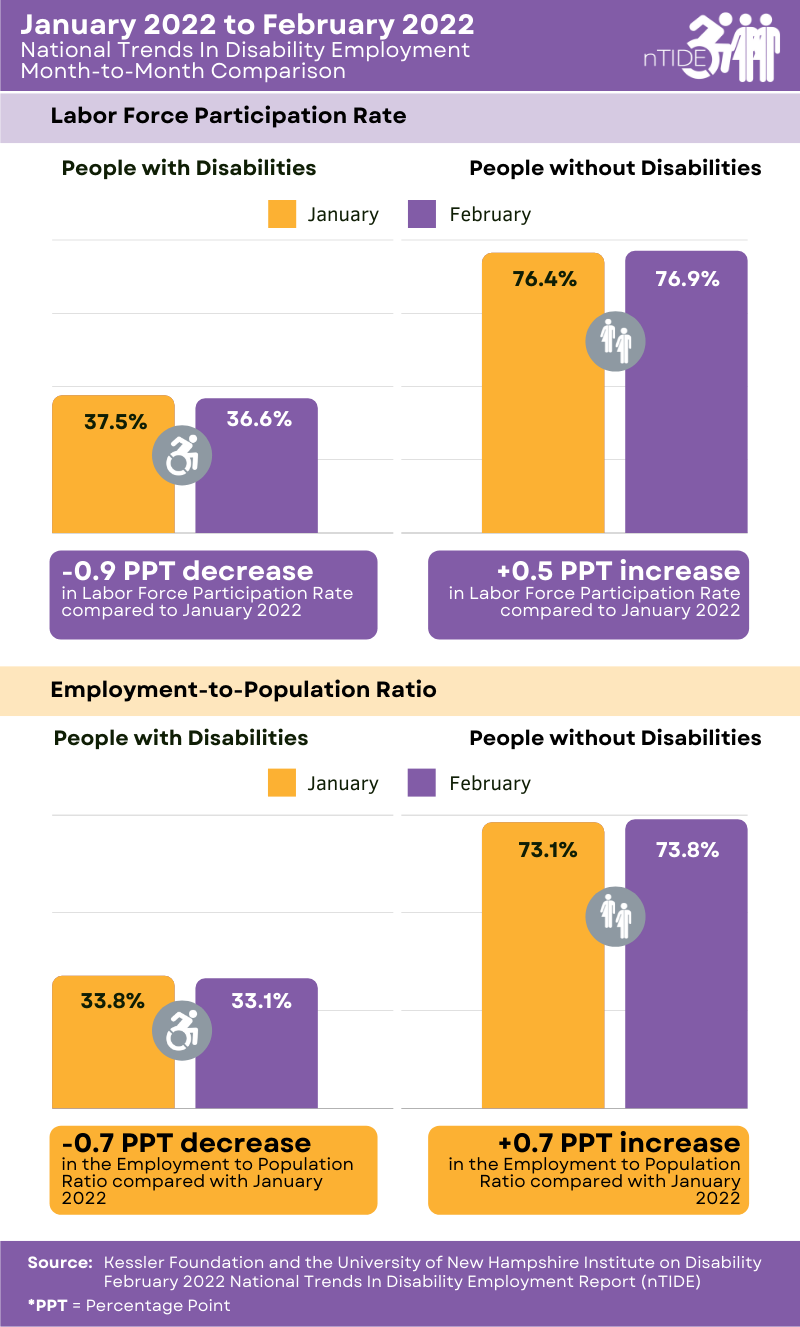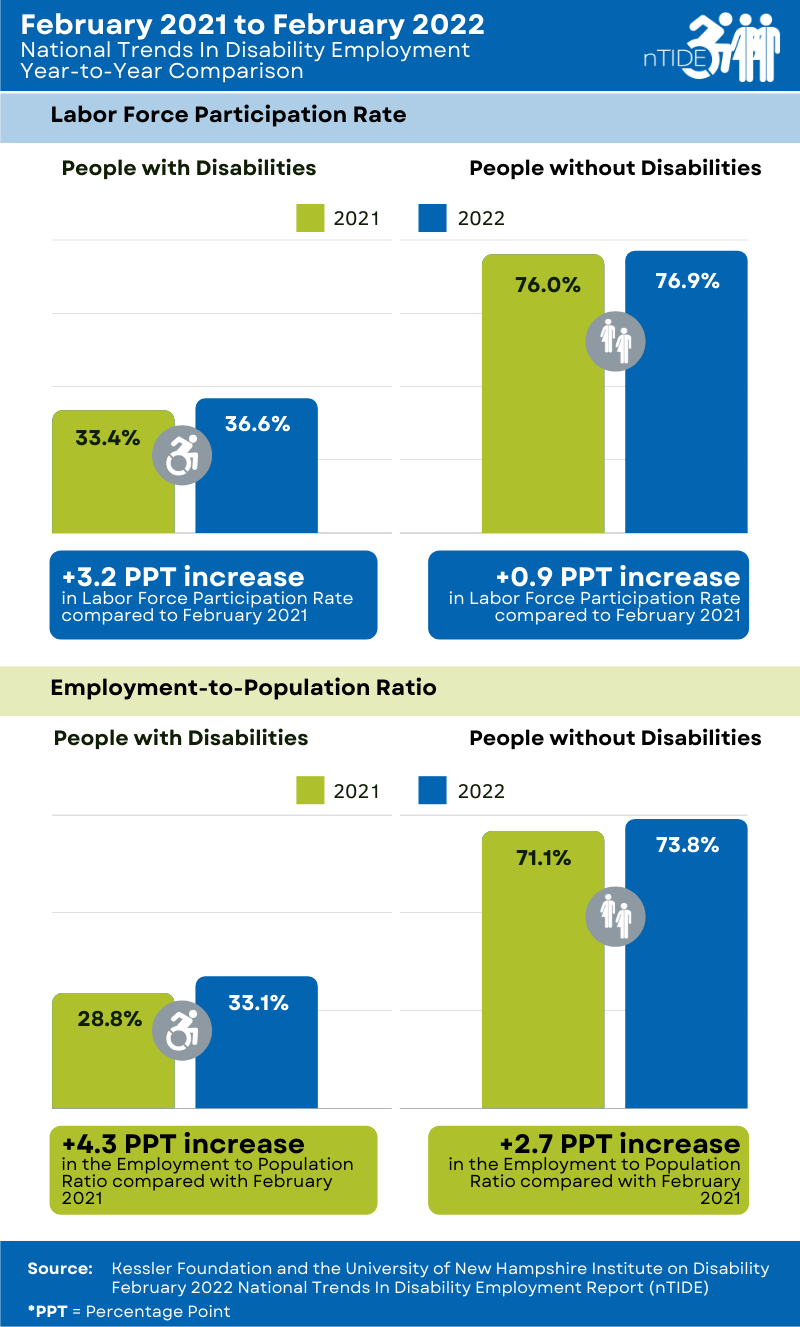National Trends in Disability Employment (nTIDE) – issued semi-monthly by Kessler Foundation and the University of New Hampshire
East Hanover, NJ – March 4, 2022 – Job numbers declined in February for people with disabilities but remained above historic highs, according to today’s National Trends in Disability Employment – Monthly Update (nTIDE), issued by Kessler Foundation and the University of New Hampshire’s Institute on Disability (UNH-IOD). The declines contrasted with small gains seen for people without disabilities, a difference that could reflect sampling variation between the two groups.

people with disabilities and increases for people without disabilities.
Month-to-Month nTIDE Numbers (January to February 2022 comparison)
In the US Bureau of Labor Statistics (BLS) Jobs Report released Friday, the employment-to-population ratio for working-age people with disabilities decreased from 33.8 percent in January to 33.1 percent in February 2022 (down 2.1 percent or 0.7 percentage points). For working-age people without disabilities, the employment-to-population ratio increased from 73.1 percent in January to 73.8 percent in February 2022 (up 1 percent or 0.7 percentage points). The employment-to-population ratio, a key indicator, reflects the percentage of people who are working relative to the total population (the number of people working divided by the number of people in the total population multiplied by 100).
The relationship of this month’s data to historic highs for people with disabilities was explained by John O’Neill, PhD, director of the Center for Employment and Disability Research at Kessler Foundation. “The employment-to-population ratio for people with disabilities declined last month,” he noted, “but remains above pre-COVID-19 pandemic levels.”
In addition, the employment-to-population ratio remains at its highest monthly level since employment data became available to disability statistics researchers in 2008. “In that year, the BLS identified people with disabilities for the first time, by adding six questions on disability to its Current Population Survey,” added Dr. O’Neill. “This means our starting point for tracking these data was just prior to the Great Recession when employment rates were relatively high for people with disabilities.”
Findings were similar for February’s labor force participation rates. For working-age people with disabilities, the labor force participation rate decreased from 37.5 percent in January to 36.6 percent in February 2022 (down 2.4 percent or 0.9 percentage points). For working-age people without disabilities, the labor force participation rate increased from 76.4 percent in January to 76.9 percent in February 2022 (up 0.7 percent or 0.5 percentage points). The labor force participation rate is the percentage of the population that is working, not working and on temporary layoff, or not working and actively looking for work.
“One thing to keep in mind when looking at labor market statistics for people with disabilities is that these statistics are based on a sample that is small relative to people without disabilities and thus, subject to greater month-to-month variations,” remarked Andrew Houtenville, PhD, professor of economics and the research director of the University of New Hampshire’s Institute on Disability. “For example, if we see a large increase in one month, we expect to see a decrease the next month or next two months, as the sample trend reverts back to its true course. That may be what we are seeing in the February numbers.”

people with and without disabilities.
Year-to-Year nTIDE Numbers (February 2021 to February 2022)
The employment-to-population ratio for working-age people with disabilities increased from 28.8 percent in February 2021 to 33.1 percent in February 2022 (up 14.9 percent or 4.3 percentage points). For working-age people without disabilities, the employment-to-population ratio also increased from 71.1 percent in February 2021 to 73.8 percent in February 2022 (up 3.8 percent or 2.7 percentage points).
The labor force participation rate for working-age people with disabilities increased from 33.4 percent in February 2021 to 36.6 percent in February 2022 (up 9.6 percent or 3.2 percentage points). For working-age people without disabilities, the labor force participation rate also increased from 76 percent in February 2021 to 76.9 percent in February 2022 (up 1.2 percent or 0.9 percentage points).
In February 2022, among workers ages 16-64, the 5,404,000 workers with disabilities represented 3.7 percent of the total 146,467,000 workers in the U.S.
Ask Questions about Disability and Employment
Each nTIDE release is followed by a nTIDE Lunch & Learn webinar. This live broadcast, hosted via Zoom Webinar, offers attendees Q&A on the latest nTIDE findings, provides news and updates from the field, as well as invited panelists to discuss current disability-related findings and events. On March 4, at 12:00 pm Eastern,, Liz Weintraub, senior advocacy specialist at AUCD, Dahlia Shaewitz from the Institute for Educational Leadership, and Michelle Yin from Northwestern University, join Drs. Houtenville and O’Neill, and Denise Rozell, Policy Strategist at AUCD. Join live or visit the archives at: ResearchonDisability.org/nTIDE.
nTIDE COVID Update
Join us on March 18 for the mid-month COVID update - an in-depth comparison of the latest unemployment numbers for people with and without disabilities. Register at: COVID-19 Updates - 2022 | Center for Research on Disability
NOTE: The statistics in the nTIDE are based on Bureau of Labor Statistics numbers but are not identical. They are customized by UNH to combine the statistics for men and women of working age (16 to 64). nTIDE is funded, in part, by grants from the National Institute on Disability, Independent Living and Rehabilitation Research (NIDILRR) (90RT5037) and Kessler Foundation.
About Kessler Foundation
Kessler Foundation, a major nonprofit organization in the field of disability, is a global leader in rehabilitation research that seeks to improve cognition, mobility, and long-term outcomes -- including employment -- for people with neurological disabilities caused by diseases and injuries of the brain and spinal cord. Kessler Foundation leads the nation in funding innovative programs that expand opportunities for employment for people with disabilities.
About the Institute on Disability at the University of New Hampshire
The Institute on Disability (IOD) at the University of New Hampshire (UNH) was established in 1987 to provide a coherent university-based focus for the improvement of knowledge, policies, and practices related to the lives of persons with disabilities and their families. For information on the NIDILRR-funded Employment Policy and Measurement Rehabilitation Research and Training Center, visit ResearchOnDisability.org.
Interested in trends on disability employment? Contact Carolann Murphy to arrange an interview with our experts: 973.324.8382
[email protected]
Twitter | Facebook | YouTube | Instagram | iTunes & SoundCloud